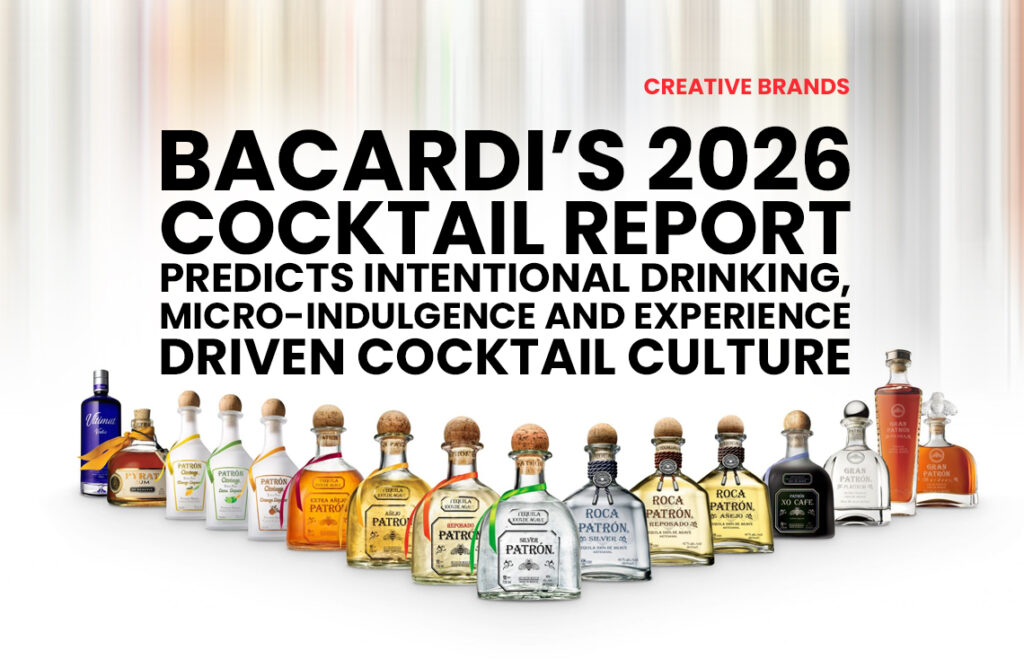The Bacardi Cocktail Trends Report 2026 reveals a shift toward intentional drinking, micro-indulgence and richer storytelling experiences. Consumers, especially Gen Z, are embracing earlier, lighter, more meaningful moments, from daycaps to mini-cocktails. Bars and brands are responding with local sourcing, community-focused spaces, innovative formats and immersive experiences shaping global cocktail culture for 2026.

Cocktail culture around the world is stepping into 2026 with a bold shift in attitude, rhythm and imagination. If earlier years were marked by experimentation and the resurgence of classic serves, the seventh annual Bacardi Cocktail Trends Report for 2026 suggests a year when people drink with more intention, seek richer meaning in every sip, and demand experiences that blend ritual, community and creativity. The report draws from extensive global consumer surveys, hundreds of field insights from Bacardi’s advocacy teams, and macro trends identified by The Future Laboratory, painting a detailed picture of how, why and what people will drink next year. What emerges is a portrait of a culture that is expanding far beyond the bar—living in new spaces, new hours of the day, and new expressions of personal identity.
At the centre of this shift is the growing influence of Gen Z drinkers of legal drinking age, who are redefining not only what they drink, but when and how. Far from being the “sober generation,” this cohort is drinking on their own terms, favouring earlier, lighter and more intentional moments. The report highlights the rise of the “daycap,” a late-afternoon indulgence that is quickly becoming the counterpart to the traditional nightcap. As hybrid lifestyles settle and office routines reshape themselves, younger consumers are embracing Thursdays as the new start to the weekend, filling post-work hours with low-ABV spritzes, dessert-inspired cocktails and mood-driven sips that fit seamlessly into their recalibrated rhythms. Bars, in response, are leaning into the changing clock: rooftop terraces are curating golden-hour menus, Michelin-star restaurants are launching early-evening tasting offerings, and venues across Europe are reinventing the after-work window as the most desirable booking slot.
In 2026, drinking is not simply about consumption—it is about micro-indulgence, a small reward that feels earned without derailing the rest of the day. This desire for intentional pleasure is driving the rise of “snackable sips” such as mini Martinis and tiny Margaritas, which combine full flavour with a cold, compact serve that appeals to consumers’ preference for quality over quantity. Sweet and fruity flavours are leading globally, driving the return of the Piña Colada as one of the top global bar calls for 2026, while bars from Manchester to Mexico City are leaning into inventive, bite-sized serves that offer novelty, ease and temperature control—addressing one of consumers’ biggest dislikes: cocktails that are not cold enough.
The report also points to a cultural shift away from digitally saturated nightlife toward more meaningful, analog-driven gatherings. Rewilding Connection, one of the key macro trends, describes a new wave of mindful socializing where people prioritize presence over performance. Instead of crowded clubs, consumers—especially Gen Z—are gravitating toward experiences that feel grounding and communal: tarot nights, reading parties, charity bingo, coffee raves, creative workshops and cultural festivals. These third spaces—cafés, community hubs, salons, galleries and bookstores—are becoming essential social venues, offering connection without pressure. Almost half of LDA Gen Z adults already use such spaces at least weekly, and these venues now generate more drinks volume per month than traditional bars. The cocktail, in this environment, becomes a companion to connection rather than the main event, with ready-to-drink (RTD) formats like the BACARDÍ & Coca-Cola tapping into the desire for low-effort, high-fun convenience.
As this shift takes hold, bars are reinventing themselves as platforms for community, creativity and cultural exchange. Some are adopting storytelling formats—like illustrated trading-card menus, omakase cocktail counters and plant-based tasting journeys—to turn drinks into conversation starters. Others are curating events, residencies and playlists that meet consumers at the intersection of culture, identity and social belonging. In London, members’ clubs have introduced surprise live performances, while in Berlin, multi-use cultural hubs are blending cocktails with art, music and urban experimentation. What ties these examples together is a desire for authenticity, spontaneity and shared experience.
Beyond social ritual, provenance emerges as another major driver shaping 2026. Consumers not only want to know what they are drinking—they want to know where it comes from, how it was made, and why its ingredients matter. The report highlights a movement toward New Localogy, where bars treat their spaces as living laboratories, merging gastronomy, agriculture and science. Vertical farms, rooftop beehives, fermentation labs and regional sourcing are no longer niche experiments but mainstream expectations. Transparency protocols, driven by upcoming regulations, will make QR-coded ingredient and lifecycle information part of the cocktail journey. This shift is inspiring new creativity: bars are using citric acid to mimic lime in regions where citrus is scarce, distilling seasonal fruits into multi-use ingredients, and crafting cocktails that lean into local terroir while still celebrating global spirits.
At the same time, ingredients are being pushed harder to serve multiple purposes—fresh, fermented, distilled or infused—to minimize waste and maximize flavour. Techniques like superjuice and parallel fermentation are redefining sustainability not as a checkbox but as a creative challenge. Venues such as Lyaness in London and Native in Singapore are embracing scientific innovation, while others, like Alquímico in Cartagena, are grounding their work in agriculture and seasonality to build transparent, circular ecosystems.
Cocktail culture in 2026 is also expanding into lifestyle terrain. Drinks are no longer just beverages—they are becoming cultural IP. From branded merch and immersive pop-ups to collaborations with sports championships and fashion houses, spirits brands are aligning themselves with broader worlds of design, performance and travel. Consumers, especially younger ones, are investing in brands that reflect their identity, with emotional engagement translating directly into higher spend. The report notes the rise of experiential opulence and maximalist mixology—venues where cocktails are high-gloss, theatrical and deeply shareable. Multi-sensory serves, levitating glasses, edible illusions and extravagant staging are driving footfall, capturing social media attention and redefining what a “special night out” looks like.
Even the cocktail menu, once a purely functional item, is evolving into a storytelling artifact—an immersive object that shapes expectations and drives decisions. Menus now act as curated worlds: vintage magazines, cinematic trailers, puzzles, art books, zines and interactive cubes. With three in five consumers checking cocktails online before visiting a venue, design and narrative now matter as much as flavour. Personalization will rise further, with consumers eager for AI-supported recommendations that still maintain the artistry and emotional nuance of human bartenders.
Taken together, the 2026 Bacardi Cocktail Trends Report suggests a year where drinking becomes more intentional, more expressive and more culturally intertwined than ever before. It is no longer merely about what is in the glass, but about the experiences, values and communities that form around it. Cocktails in 2026 are tools of identity, vehicles of connection and gateways to micro-moment indulgence—crafted not just to be consumed, but to be lived.







